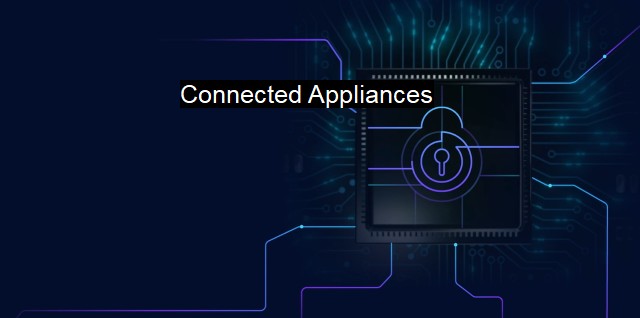What are Connected Appliances?
The Internet of Things (IoT): Risks and Cybersecurity Threats in Connected Appliances
Connected appliances refer to smart electronic devices ranging from home security systems, thermostats, entertainment devices to even kitchen, laundry and bathroom appliances like refrigerators, washing machines, etc. These innovative tools are designed to simplify the users' lives by allowing remote accessibility and controlling of devices, leveraging the power USB connectivity, Wi-Fi, or UWB (Ultra-Wideband).When we refer to connected appliances in cybersecurity and antivirus lexicon, we are alluding to a perennial theme known as the Internet of Things (IoT), a concept that mainstream cyber discourse can't do without. The context establishes how these 'smart' appliances, which can interact with a digital ecosystem, bring all sorts of cyber vulnerabilities, underscoring the essence of deep-rooted cyber hygiene, owing to their manipulability and sensitive data they can hold or generate.
Cybersecurity for connected appliances becomes primary as they interact within an interconnected network; a threat to one can expose the entire ecosystem to cyber risks. Devices like connected refrigerators or smart TV systems have inbuilt software replete with consumer data and other household usage patterns, served on a platter for skilled cybercriminals targeting such devices. Past instances include web hackers gaining unauthorized access to smart baby-monitors or pacemakers becoming the prey to ransomware, planting the seeds of misuse and robbery of sensitive personal information.
These new-age 'smart' home appliances need to maintain necessary cyber hygiene and must be equipped with high-security UNIX based or Linux based operating systems and must also be encrypted at both ends. They must be configured with robust and unique passwords and must essentially exist in a segmented network, ensuring relative isolation vis-à-vis other online ecosystems. An outdated appliance software is a playground for potential cyber-attacks; they must also work integrated with the latest patches, or else it runs the threat of being compromised.
Adding physical security measures to IoT devices can also complement these cyber hygiene practices as a part of comprehensive cybersecurity strategies for connected appliances. This entire activity leverages the strength of embedded devices and endpoint security, meaning recurrent diagnostics and check-ups to attribute the constant threat intelligent devices might face.
One more angle from where cybersecurity plays a crucial role is the legal aspect related to data privacy of connected appliances. The data that these devices store and share creates a scope for breach into proprietorship rights of consumers and leads to ensuing implications. Therefore, legitimate frameworks around cybersecurity become inevitable, articulating device manufacturing standards, subsequent secure installation, data handling, and transparent sale agreement to plug all loopholes.
By supplementing them with superior interfaces backed by efficient antivirus software, chances of malicious attacks can significantly be curbed, steering clear from vulnerabilities these appliances attract otherwise. Antivirus in connected appliances showcase complete security systems. They are the steel armor protecting the digital assets of users from malware, adware, ransomware, spy bots, menacing phishing mails, browser hackers amongst others.
Categorically 'connected appliances' represent efficient human labor-savers. They do so while functioning on revolutionary innovative technologies, constituting data generation and massive exchange between computers and these appliances. Consequently, for such digital transfers without being underway to constant exposure to cyber threats and promising systems stability, being enveloped under robust cybersecurity norms and antivirus protection as tools becomes a sine qua non. Therefore, the dichotomy exists, pushed into using comprehensively digitized devices for their functionality, then subjected to the implementation of comprehensive cybersecurity tactics. This vital progression just doesn't conclude with virus check or turning on an update; it expands to user responsibility and conscious usage ensuring the desired functionality of the interconnected system.

Connected Appliances FAQs
What are connected appliances?
Connected appliances refer to everyday household devices that can connect to the internet and communicate with other devices. Examples include smart TVs, smart thermostats, smart refrigerators, and smart home security systems.Why do I need antivirus software for my connected appliances?
Antivirus software is important for connected appliances to protect against cyber threats. As more and more devices become connected to the internet, they become potential targets for hackers. Antivirus software can detect and prevent malware, ransomware, and other cyber attacks that could compromise your device and put your personal information at risk.How can I ensure the security of my connected appliances?
To ensure the security of your connected appliances, you should follow basic cybersecurity practices such as setting strong passwords, updating software regularly, and using antivirus software. It is also important to only use trusted apps and websites to access your appliances, and to be wary of suspicious emails or messages that may contain phishing scams.What should I do if one of my connected appliances is compromised by a cyber attack?
If you suspect that one of your connected appliances has been compromised by a cyber attack, you should immediately disconnect the device from the internet and shut it down. Contact the manufacturer for advice on how to resolve the issue and strengthen the security of your device. You may also need to contact your internet service provider or a cybersecurity expert for further assistance.| | A | | | B | | | C | | | D | | | E | | | F | | | G | | | H | | | I | | | J | | | K | | | L | | | M | |
| | N | | | O | | | P | | | Q | | | R | | | S | | | T | | | U | | | V | | | W | | | X | | | Y | | | Z | |
| | 1 | | | 2 | | | 3 | | | 4 | | | 7 | | | 8 | | |||||||